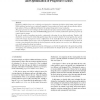Free Online Productivity Tools
i2Speak
i2Symbol
i2OCR
iTex2Img
iWeb2Print
iWeb2Shot
i2Type
iPdf2Split
iPdf2Merge
i2Bopomofo
i2Arabic
i2Style
i2Image
i2PDF
iLatex2Rtf
Sci2ools
CGF
1998
1998
Using Wavefront Tracing for the Visualization and Optimization of Progressive Lenses
Progressive addition lenses are a relatively new approach to compensate for defects of the human visual system. While traditional spectacles use rotationally symmetric lenses, progressive lenses require the specification of freeform surfaces. This poses difficult problems for the optimal design and its visual evaluation. This paper presents two new techniques for the visualization of optical systems and the optimization of progressive lenses. Both are based on the same wavefront tracing approach to accurately evaluate the refraction properties of complex optical systems. We use the results of wavefront tracing for continuously re-focusing the eye during rendering. Together with distribution ray tracing, this yields high-quality images that accurately simulate the visual quality of an optical system. The design of progressive lenses is difficult due to the trade-off between the desired properties of the lens and unavoidable optical errors, such as astigmatism and distortions. We use...
| Added | 21 Dec 2010 |
| Updated | 21 Dec 2010 |
| Type | Journal |
| Year | 1998 |
| Where | CGF |
| Authors | Joachim Loos, Philipp Slusallek, Hans-Peter Seidel |
Comments (0)

